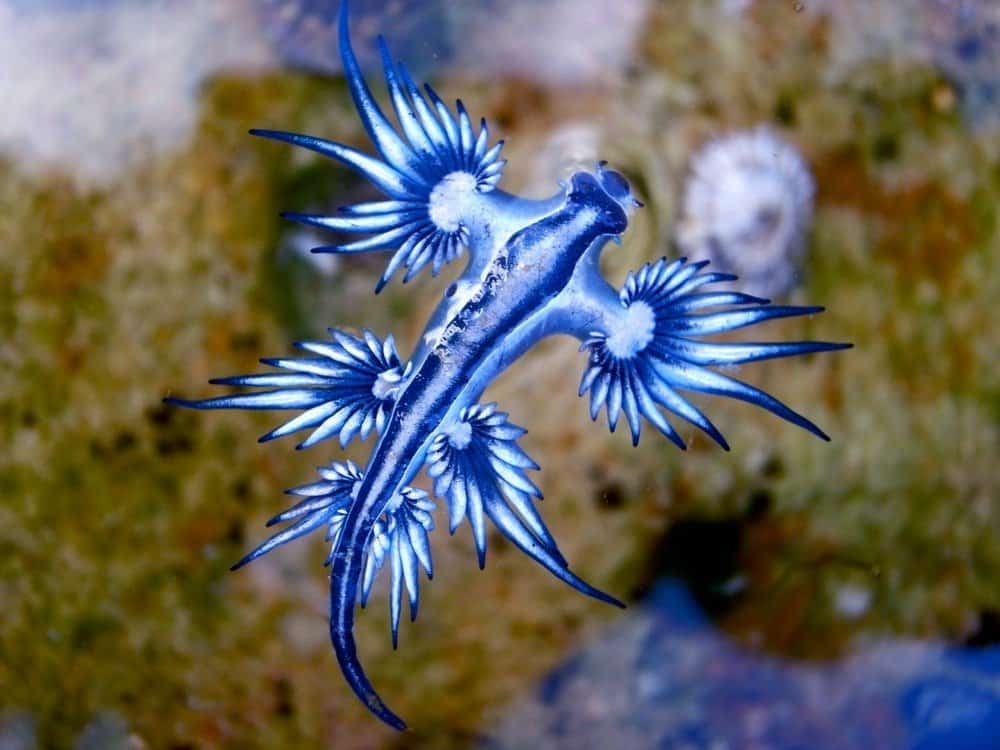Sea Slug
.jumbotron {
background-image: url(“https://a-z-animals.com/media/animals/images/original/sea_slug6-400×300.jpg”);
}
}
@media only screen and (min-width: 641px) and (max-width: 920px) {
.jumbotron {
background-image: url(“https://a-z-animals.com/media/animals/images/original/sea_slug6-470×370.jpg”);
}
}
@media only screen and (min-width: 921px) {
.jumbotron {
background-image: url(“https://a-z-animals.com/media/animals/images/original/sea_slug6.jpg”);
}
}
All sea slugs have both male and female sex organs
Sea Slug Scientific Classification
- Kingdom
- Animalia
- Phylum
- Mollusca
- Class
- Gastropoda
- Order
- Nudibranchia
- Family
- Opistobranches
- Genus
- Nudibranch
- Scientific Name
- Nudibranchia
Read our Complete Guide to Classification of Animals.
Sea Slug Conservation Status
Sea Slug Facts
- Main Prey
- Plankton, plant matter, jelly fish
- Group Behavior
-
- Solitary
- Fun Fact
- All sea slugs have both male and female sex organs
- Estimated Population Size
- Unknown
- Biggest Threat
- Water pollution
- Most Distinctive Feature
- Colorful patterns
- Other Name(s)
- Pteropods, gastropod mollusks
- Gestation Period
- 5-50 days
- Optimum pH Level
- 7.5-8.4
- Habitat
- Shallow and deep areas of oceans
- Predators
- Fish, lobsters, crabs, humans
- Diet
- Herbivore
- Favorite Food
- Algae
- Type
- Herbivore
- Common Name
- Sea Slug
- Average Clutch Size
- 500
This post may contain affiliate links to our partners like Chewy, Amazon, and others. Purchasing through these helps us further the A-Z Animals mission to educate about the world’s species..

Spiders that fly! Fish that walk! And 1000+ more incredible animals. Discover them all for FREE
.photo-gallery {
–margin: 0px auto 0px;
–padding: 0px 0px 0px 0px;
}
.gallery-link {
background-image: url(“https://a-z-animals.com/media/animals/images/original/sea_slug6.jpg”);
background-repeat: no-repeat;
background-size: cover;
background-position: center;
height: 500px;
justify-content: center;
text-align: center;
align-items: center;
display: flex;
border: 2px solid #000;
}
.gallery-link img {
height: 50%;
}
@media only screen and (max-width: 768px) {
.gallery-link {
height: 300px !important;
}
}
View all of the Sea Slug images!
Sea Slugs are tiny animals known for their bright colors and intricate patterns.
One of the most important facts to remember about sea slugs is there are over 2,000 species. TThey are found in both shallow and deep areas of oceans. In Asia, sea slugs are a form of cuisine.
3 Incredible Sea Slug Facts!
- Poisonous skin: Some sea slugs eat prey that contains poison. Instead of killing them, this animal stores the poison and releases it as protection against predators.
- Male and female: All sea slugs contain both male and female organs. So, when they mate with another animal they both release eggs.
- Cannibals: Sea slugs are known to eat each other. They may eat a dead sea slug or attack a live one to eat it. Not surprisingly, animals that are larger in size usually prey on smaller ones.
Sea Slug Classification and Scientific Name
The scientific name of a sea slug is Nudibranchia. The name Nudibranchia is Latin for naked gills. This refers to the animal’s lack of a shell as well as the feather-like gills and horns on its body. These animals are also called gastropod mollusks and pteropods.
There are over 2,000 species of sea slug. In short, sea slug is a common name standing for many types of these animals. They belong to the Gastropoda class, the family of Opistobranches and are in the phylum Mollusca.
Sea Slug Species
There are species of this animal living throughout the world. There happen to be 8 species living in the Chesapeake Bay. The level of salinity in the Chesapeake Bay makes this an ideal environment for them. Some of the types living in the bay include:
- The bushy-backed nudibranch: This animal could easily be mistaken for an underwater plant. It has what appear to be prickly branches sticking out of its back. It can be brown to gray in color and is just 2 inches long.
- The ridge-backed nudibranch: The ridges all over this animal’s body earned it the name ridge-backed nudibranch. It’s white/yellow in color and lives under rocks and within gatherings of seaweed.
- The striped nudibranch: This animal measures 3-6 inches in length. It’s brown with a pattern of white stripes. Its rhinophores (scent receptors) look like two small clubs.
- The frosty-tipped nudibranch: This animal is known by the white tips on the cerata, or horns, on its back. They are yellowish in color and their skin has an opaque appearance.
Sea Slug Appearance
The appearance of these animals depends on its species. Most of them have cerata on their body. Also, most have rhinophores, or scent receptors, on the top of their head. They can range from one eighth of an inch to 12 inches in length. Furthermore, they can weigh up to 3.3 pounds.
One of the most colorful types is known as the blue dragon. It has a blue body, dark blue stripes on its head, and silver on its back. One of the most interesting facts about this animal is its cerata look like slim fingers on both sides of its body. It usually grows to be 1.2 inches in length.
The Spanish dancer is another notable animal belonging to the phylum Mollusca. Its flat body is a bright orangish-red. It can grow to be 11 inches long. It folds and unfolds itself as it swims.
The black sea hare is an exception to the small size of most of these animals. It is the largest species measuring 39 inches and weighing 31 pounds!
While some sea slugs feature colors that blend into their underwater habitat, others have toxins in their skin that help to fend off predators.

Sahara Frost/Shutterstock.com
Sea Slug Distribution, Population and Habitat
These animals live in oceans throughout the world. They live along the eastern and western coasts of both North and South America. They live off the coast of Europe, Asia, Africa, and Australia. They live in temperate to tropical areas of saltwater. Some live in shallow areas while others live at depths of 2,300 feet beneath the surface.
The Blue Glaucus also known as the blue dragon sea slug, is considered Endangered. This is due in part to water pollution. They’re also captured and sold on the exotic pet market.
Otherwise, the animal’s population is described as Stable. Their official conservation status is Least Concern.
Sea Slug Predators and Prey
Sea Slugs: What eats sea slugs?
Fish, crabs, and lobsters are all predators of these animals. Because of their small size, these animals are vulnerable to many other sea creatures. However, the poison they carry in their skin serves as an effective defense against many predators.
Humans are also predators of sea slugs. Some species are captured and sold on the exotic pet market. Others are captured and eaten.
Another environmental threat to these animals is water pollution. The official conservation status of sea slugs is Least Concern with a stable population.
Sea Slugs: What do sea slugs eat?
Plankton, algae, and jellyfish are all prey of these animals. Some of these animals are herbivores eating algae and other plant life off rocks. Others are carnivores eating plankton and other sea creatures.
Blue dragons are carnivores eating man-o-war jellyfish. As it eats the man-o-war jellyfish, the blue dragon absorbs poison from its prey and can turn the same poison on a predator.
Sea Slug Reproduction and Lifespan
These animals have both male and female sex organs. They lay egg masses that can sometimes contain over one million eggs. Some, like the blue dragon, lay eggs on the carcasses of their prey. Others lay their eggs on floating logs or vegetation.
The age of sexual maturity depends upon the animal’s lifespan.
The incubation period of the eggs ranges from 5 to 50 days. The animal’s lifespan is from 1 to 4 years depending on its species.
Sea Slugs in Fishing and Cooking
These animals are caught and sold in the exotic pet trade. They are slow and can easily be caught in a net.
The animal’s skin is roasted and dried. They’re eaten in China and other parts of Asia. Some have reported that they have a bitter taste due to the mucous on their skin.
When this animal is on the menu, it’s usually served with vegetables especially mushrooms and cabbage. They are known to be low in calories and high in protein.
View all 186 animals that start with S
Sea Slug FAQs (Frequently Asked Questions)
What is a sea slug?
Sea slugs are small, slow-moving ocean creatures known for their bright colors and intricate patterns. They can measure an eighth of an inch long to 12 inches. Oftentimes, they have horns on their body and scent receptors called rhinophores on their head.
Where are sea slugs found?
These creatures are found in oceans throughout the world. They live in temperate to tropical waters. Sea slugs can live in shallow water or thousands of feet down in the ocean.
What do sea slugs eat?
Some sea slugs are herbivores eating algae and other plant life. Others are carnivores eating plankton, jellyfish, and other animals.Sea slugs will eat whatever prey is most abundant in their environment.
Where do sea slugs live?
They live under rocks, in crevices, and near coral reefs.
What does a sea slug look like?
A sea slug can be one color or several. Some have stripes while others have spots. Some sea slugs have horns all over their body while others are flat. It all depends on the species.
Are sea slugs dangerous?
They can be. The skin of a sea slug contains a poison that can be passed along to a human through a sting.
What Kingdom do Sea Slugs belong to?
Sea Slugs belong to the Kingdom Animalia.
What phylum do Sea Slugs belong to?
Sea Slugs belong to the phylum Mollusca.
What class do Sea Slugs belong to?
Sea Slugs belong to the class Gastropoda.
What family do Sea Slugs belong to?
Sea Slugs belong to the family Opistobranches.
What order do Sea Slugs belong to?
Sea Slugs belong to the order Nudibranchia.
What genus do Sea Slugs belong to?
Sea Slugs belong to the genus Nudibranch.
What type of covering do Sea Slugs have?
Sea Slugs are covered in Smooth skin.
What are some predators of Sea Slugs?
Predators of Sea Slugs include fish, lobsters, crabs, and humans.
What is the average clutch size of a Sea Slug?
Sea Slugs typically lay 500 eggs.
What is the scientific name for the Sea Slug?
The scientific name for the Sea Slug is Nudibranchia.
What is a distinguishing feature of the Sea Slug?
Sea Slugs have colorful patterns.
What is the lifespan of a Sea Slug?
Sea Slugs can live for 1 to 4 years.
What is the biggest threat to the Sea Slug?
The biggest threat to the Sea Slug is water pollution.
What is the optimal pH for a Sea Slug?
The optimal pH for a Sea Slug is between 7.5 and 8.4.
What is another name for the Sea Slug?
The Sea Slug is also called the pteropod or gastropod mollusk.
How many Sea Slugs are left in the world?
The population size of the Sea Slug is unknown.
How fast is a Sea Slug?
A Sea Slug can travel at speeds of up to 0.2 miles per hour.
How do Sea Slugs have babies?
Sea Slugs lay eggs.
Sources
- Wikipedia, Available here: https://en.wikipedia.org/wiki/Nudibranch
- Reef Biosearch, Available here: https://www.greatbarrierreefs.com.au/blue-seaslug/index.html
- New Heaven Reef Conservation, Available here: https://newheavenreefconservation.org/learning-resources/explore-topics/nudibranchs-and-other-sea-slugs
















